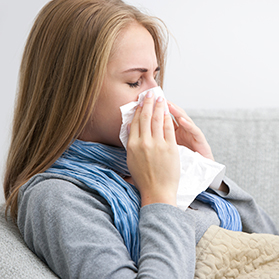Red, Yellow and Green, Oh My! What the Color of Your Snot Says About Your Health.

Yellow, green and red are all colors of fall, but we’re not just talking about leaves. With fall on the horizon and the weather turning cooler, you might find yourself sniffling more than usual. Our nose can run for many reasons, but have you ever wondered what the color of your snot says about your health?
“Typically, nasal secretions start clear and watery but can change in color and thickness and become secondarily infected,” says Mark Deutsch MD, an ear-nose-and-throat doctor with Group Health.
Does Clear Drainage Mean I’m in the Clear?
Clear nasal drainage is common with late summer allergies due to increased pollen and ragweed in the air, and fall leaves carry mold, which can lead to sinus congestion and nasal drainage.
Similar to allergies, nasal drainage associated with the common cold and respiratory infections, which increase in kids once school is back in session, begins with a clear color.
“If you have a cold or respiratory infection, your drainage will start clear, and can become thicker, and eventually turn off-color,” Dr. Deutsch says. “If your drainage stays clear, it’s most likely viral, and will likely pass on its own.”
Treatment methods range from decongestants (Sudafed), increased fluid intake, over-the-counter remedies, including ibuprofen (Advil) or acetaminophen (Tylenol), and time.
Yellow or Green Drainage: Should I be Concerned?
Bacterial infections see more significant drainage that is cloudy, off-colored, or even yellow or green. “If you have a bacterial infection, you might also experience facial pain, swelling, vision disturbances or a significant headache,” Dr. Deutsch explains. “If nasal secretion doesn’t clear or resolve over seven to ten days, then I’d want the patient seen by a healthcare provider.”
With this type of drainage, since it’s bacterial, an antibiotic may need to be prescribed to clear up your symptoms.
Nose Bleeds Rise During Fall
Nose bleeds coincide with turning off the air conditioner and turning on the furnace, but subside once more humid air is introduced back into your home.
“The air inside becomes less humidified, and increasingly more dry, which can lead to nose bleeds, some of which can be severe,” Dr. Deutsch says.
Prevention: How do I Protect Myself?
If you suffer from allergies, be proactive with treatment and start taking an antihistamine or prescription medication before and during allergy season. For colds and bacterial infections, hand hygiene and hand washing are effective methods you can use to diminish your exposure germs.
Additional supportive measures include:
- Nasal saline/spray/neti pot to clear nasal secretions
- Decongestants
- Increased fluid intake